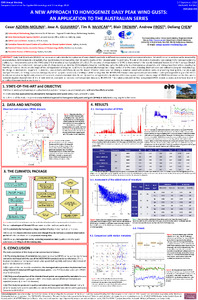Por favor, use este identificador para citar o enlazar este ítem:
http://hdl.handle.net/20.500.11765/11955
A new approach to homogenize daily peak wind gusts: an application to the Australian series
| Título : | A new approach to homogenize daily peak wind gusts: an application to the Australian series |
| Autor : | Azorín Molina, César; Guijarro Pastor, José Antonio


|
| Palabras clave : | Daily peak wind gusts; Homogenization |
| Fecha de publicación : | 2018 |
| Citación : | EMS Annual Meeting (2018) |
| Versión del editor: | https://dx.doi.org/10.13140/RG.2.2.29670.68161 |
| Resumen : | Daily Peak Wind Gusts (DPWG) time-series are valuable data for the evaluation of wind related hazard risks to different socioeconomic and environmental sectors. Yet wind time-series analyses can be impacted by several artefacts, both temporally and spatially, that may introduce inhomogeneities that mislead the studies of their decadal variability and trends. The aim of this study is to present a new strategy in the homogenization of a challenging climate extreme such as the DPWG using 548 time-series across Australia for 1941-2016. This automatic homogenization of DPWG is implemented in the recently developed Version 3.0 of the R package Climatol. The new approach is an advance in homogenization of climate records as identifies 353 breakpoints based on monthly data, splits the daily series into homogeneous sub-periods, and homogenizes them without needing the monthly corrections. The major advantages of this homogenization strategy are its ability to: (i) automatically homogenize a large number of DPWG series, including short-term ones and without needing site metadata (e.g., the change in observational equipment in 2010/2011 was correctly identified); (ii) use the closest reference series even not sharing a common period with candidate series or presenting missing data; and (iii) supply homogenized series, correcting anomalous data (quality control by spatial coherence), and filling in all the missing data. The NCEP/NCAR reanalysis wind speed data was also trialled in aiding homogenization given the station density was very low during the early decades of the record; however, reanalysis data did not improve the homogenization. Application of the new approach found a reduced range of DPWG trends based on site data, and an increased negative regional trend of this climate extreme, compared to raw data and homogenized data using NCEP/NCAR. The analysis produced the first homogenized DPWG dataset to assess and attribute long-term variability of extreme winds across Australia. |
| Descripción : | Póster presentado en: EMS Annual Meeting - European Conference for Applied Meteorology and Climatology 2018, celebrado en Budapest del 3 al 7 de septiembre de 2018. |
| Patrocinador: | This work has been also supported by the Project “Detection and attribution of changes inextreme wind gusts over land ”(2017-03780) funded by the Swedish Research Council, and the MULTITEST (Multiple verification of automatic software homogenizing monthly temperatura and precipitation series; CGL2014-52901-P) project, funded by the Spanish Ministry of Economy and Competitivity. |
| URI : | http://hdl.handle.net/20.500.11765/11955 |
| Colecciones: | EMS Annual Meeting and European Conference on Applications of Meteorology - Póster |
Ficheros en este ítem:
| Fichero | Descripción | Tamaño | Formato | ||
|---|---|---|---|---|---|
| Azorin_Molina_et_al_E... | 3,16 MB | Adobe PDF |  Visualizar/Abrir |
Los ítems de Arcimis están protegidos por una Licencia Creative Commons, salvo que se indique lo contrario.





